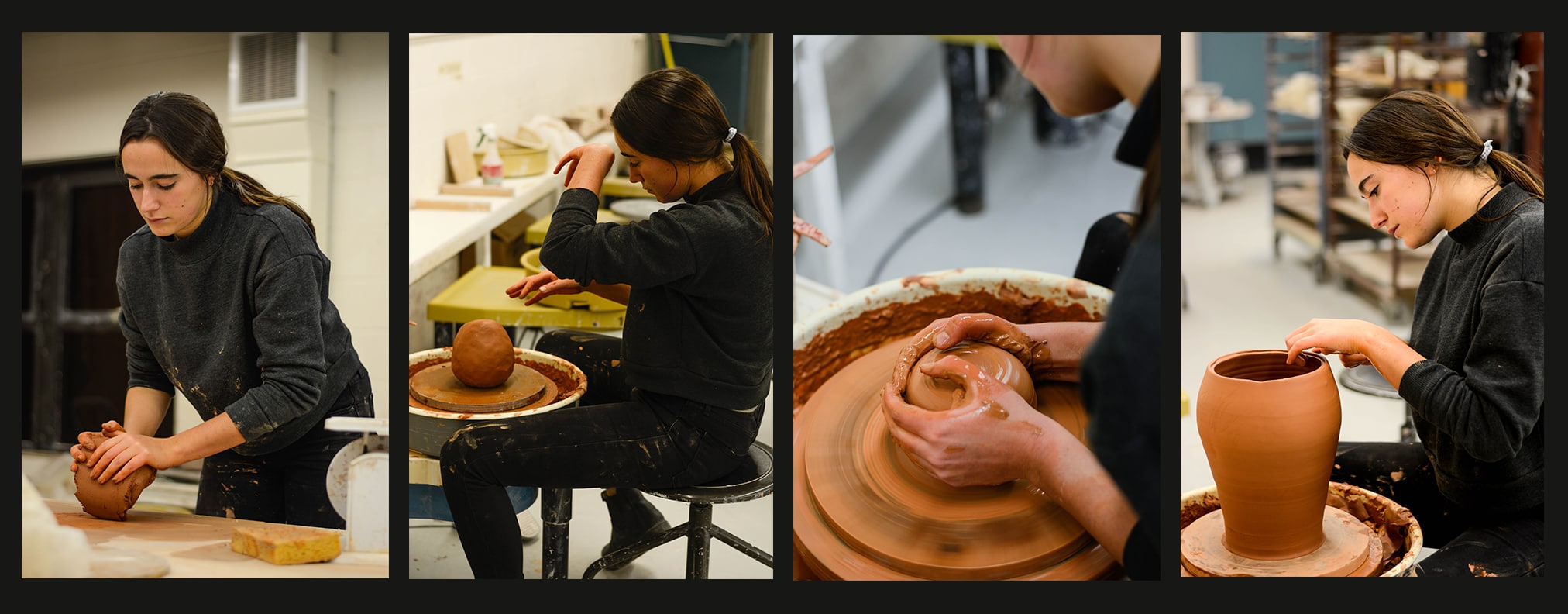Senior ceramic artist pulls inspiration from home and abroad
Artist Isabel Souza is inspired by home and abroad

Isabel “Izzy” Souza likens a damaged pot to a death in the family. She does this with a laugh, but she means it – at least a little. Earlier this year one of her biggest projects – a large clay pot more than three feet in height – exploded in the kiln, leaving an irreparable gaping hole in its side.
“At least I learned something from it, but still,” she says. “It’s just sad.”
The senior fine arts major from Cape Cod, Massachusetts has worked with clay since kindergarten when she tried it at an after-school program. After that, she learned wheel throwing at her local arts center and continued exploring different mediums until high school, when a teacher inspired her to seriously pursue ceramics.
The pieces in Souza’s studio in Syracuse range in size and style, but many are mugs and cups that have botanical etchings and prints, the result of spending lots of time at home outside, and growing up in a family where everyone but her gardens. Still, “Clay is dirt.”
While searching for colleges nearly four years ago, Souza didn’t want to attend an exclusive art school. She wanted to enroll in a university where she could explore other interests like business, fashion and photography, and she feels that she found that in Syracuse.
“It’s a challenge for me to think about just strictly being a potter for a living,” says Souza. “That’s not really something that I want to go for after I graduate. I’m kind of overwhelmed in a sense with all these things I love to do equally.”
Last spring, Souza traveled while studying abroad in Italy, and the experiences from that semester have influenced her work this year. The first ill-fated giant pot now has a successor, another giant pot that she plans to detail with a decorative style she saw in Portugal called azulejo. The elaborate technique is typically used on roof tiles, but Souza has been developing her own technique of screen printing similar patterns straight onto her clay pottery.
“It’s very Izzy, kind of,” says senior Chelsea Hurd, a classmate of Souza who also saw the intricate Azulejo tiles in Lisbon while she was abroad. “Because it’s where function meets aesthetic.”
Hurd says function comes first. The roof tiles are for durable infrastructure, but the decoration is where designers have the freedom to do anything they want.
That is, assuming that all goes well with the initial construction. Which doesn’t always happen, explains fellow senior studio arts major Sam Slate. During a critique of their work, Slate overheard a professor talking to Souza about the unpredictability of ceramics, compared to other mediums where the artist and the technique are all that matter.
“There’s a third character in there that affects your work, and that’s the clay itself,” says Slate. “The clay is a major teacher for us.”
This is partly why Hurd admires Souza’s calm demeanor in the work room. She says Souza is confident, almost stoic, and that her comfort reads into how she talks about her work and other people’s work.
“The world is so fast,” says Souza. “Everyone is basing their decisions off of efficiency and speed and technology. And this is kind of like my thing that allows me to step away from all of that.”
Souza estimates that she and her classmates spend upwards of 30 hours a week in the studio spaces. Since Slate’s desk is directly next to hers, they spend plenty of time critiquing each other’s work and offering advice. She says studio arts students don’t usually collaborate to produce one collective product, but they are willing to help each other with individual work.
“But you can go to anyone and they will put down whatever they’re doing and help you,” Souza says.
Still, she admits that having so many people in and out of common work spaces does keep her on edge and protective of her fragile work. “People probably think I’m giving them dirty looks and it’s because I am,” says Souza, after describing a near miss with another artist’s elbow and a pot she’d just thrown.
“You can’t really get bored,” she says. “There’s just so much to know between the technology and the chemistry and the process and function.”
Even as Souza has explored printmaking, metalsmithing, photography and fashion design, ceramics remains a constant.
“She’s willing to take so much work into one pot, and put so much effort into every stage of its production,” says Hurd. “This is her language, this is her identity, this is where she’s going to be forever, from where I can tell.”





